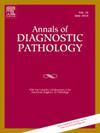Utility of the manual hematology cell counter for Ki-67 assessment in gastrointestinal and pancreatobiliary well-differentiated neuroendocrine tumors
IF 1.4
4区 医学
Q3 PATHOLOGY
引用次数: 0
Abstract
In the World Health Organization (WHO) 5th edition, prognosis of gastrointestinal (GI) well-differentiated neuroendocrine tumors (WDNET) depends on proliferation rate, commonly assessed by ki-67 immunohistochemical stain. In daily practice, the gold standard for WHO grade assessment by ki-67 staining, printing a photo of a tumor hotspot, counting the number of ki-67-positive cells out of 500 tumor cells, and calculating a percentage, is time-consuming and many cases are eyeballed. This study investigates the utility of a common tool, the manual cell counter used in hematology smear cell counting, for GI WDNET ki-67 counting. Of 59 resections, the number of cases with a WHO grade difference between gold standard print-and-count and the original report, eyeballing, and hematology counter method, was 23 (39 %), 14 (24 %) and 7 (12 %) cases, respectively. Of 37 biopsies, the number of cases with a WHO grade difference between gold standard print-and-count and the original report, eyeballing, and hematology counter method, was 10 (27 %), 12 (32 %) and 7 (19 %) cases, respectively. For resections, Chi square analysis comparing hematology counter method versus original report, where many cases were likely eyeballed, showed statistically significantly less cases with differing WHO grades from gold standard print-and-count for hematology counter-assessed cases (P = 0.0007), and the same Chi square analysis was marginally not significant (P = 0.09) for hematology counter versus eyeballing. Times taken to perform hematology counter method were statistically significantly lower than times taken for print-and-count. This study suggests the hematology cell counter could strike a reasonable balance between time and accuracy for WDNET resections.
手工血液学细胞计数器在胃肠道和胰胆道高分化神经内分泌肿瘤Ki-67评估中的应用
在世界卫生组织(WHO)第5版中,胃肠道(GI)高分化神经内分泌肿瘤(WDNET)的预后取决于增殖率,通常用ki-67免疫组织化学染色来评估。在日常实践中,WHO分级评估的金标准是ki-67染色,打印肿瘤热点照片,计算500个肿瘤细胞中ki-67阳性细胞的数量,并计算百分比,这是耗时的,许多病例是目测的。本研究调查了血液学涂片细胞计数中常用的手工细胞计数器对GI WDNET ki-67计数的效用。在59例切除中,金标准印刷计数法与原始报告、目测法和血液学计数法之间存在WHO分级差异的病例数分别为23例(39%)、14例(24%)和7例(12%)。在37例活组织检查中,金标准印刷计数法与原始报告、眼球计数法和血液学计数法之间存在WHO分级差异的病例数分别为10例(27%)、12例(32%)和7例(19%)。对于切除,比较血液学计数法与原始报告的卡方分析显示,血液学反评估病例与金标准印刷计数的WHO分级不同的病例在统计学上显著减少(P = 0.0007),同样的卡方分析在血液学计数法与目测法方面没有显著性差异(P = 0.09)。血液学计数法所用时间显著低于打印计数法所用时间。本研究提示血液学细胞计数器可以在WDNET切除术的时间和准确性之间取得合理的平衡。
本文章由计算机程序翻译,如有差异,请以英文原文为准。
求助全文
约1分钟内获得全文
求助全文
来源期刊
CiteScore
3.90
自引率
5.00%
发文量
149
审稿时长
26 days
期刊介绍:
A peer-reviewed journal devoted to the publication of articles dealing with traditional morphologic studies using standard diagnostic techniques and stressing clinicopathological correlations and scientific observation of relevance to the daily practice of pathology. Special features include pathologic-radiologic correlations and pathologic-cytologic correlations.

 求助内容:
求助内容: 应助结果提醒方式:
应助结果提醒方式:


